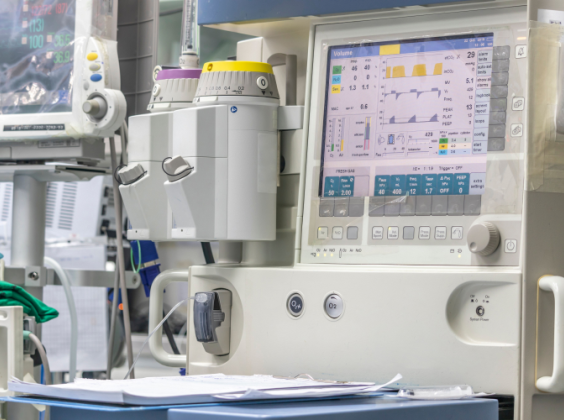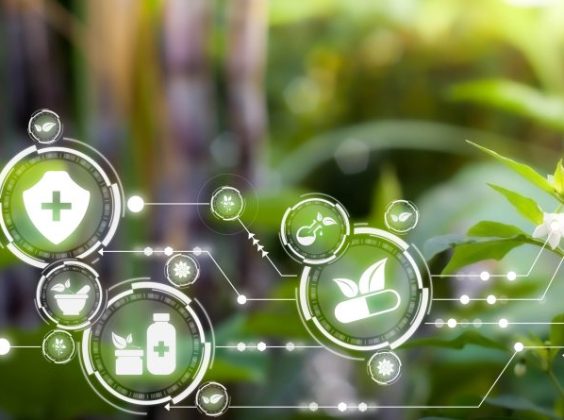
Written by

In light of the COVID-19 pandemic and the more recent warnings our damaged earth has sent to us through global warming related events, the topic of sustainability is becoming more and more important. Healthcare manufacturers have started to take note of the impact they can have on the environment and opportunities to create a more sustainable future through product innovations. There is also a growing acceptance of the role that healthcare professionals have, to ensure not only high quality, but also sustainable care.
Sustainability is a focus
The mounting concern over the ability to provide high-quality care to our growing population is often at the forefront of healthcare providers’ minds. The pressure to support the aging population that requires more advanced healthcare is in turn prompting healthcare facilities to assess their provision and opt for solutions that are not only sustainable but cleaner to the environment. Philips’ most recent Health Index report published in 2022 highlighted the change in priority for healthcare facilities to implement sustainable healthcare practices. The report estimated that in 2022 24% of healthcare leaders viewed sustainability as a key priority (a rise of 20% from 2021). However, despite this exponential rise in the number prioritising sustainability, the number is expected to remain at the same level in 3-years’ time (a reduction from the 58% expected by 2024 that was announced in the 2021 report). The report also found that ‚ÄòClinical leaders are less likely to prioritise sustainability than their operational colleagues today and this difference is even greater in the future. It also concluded that sustainability is not only something a healthcare provider is striving to achieve within their facility, but also what they look for from the leading manufacturers, especially those within the supply chain.
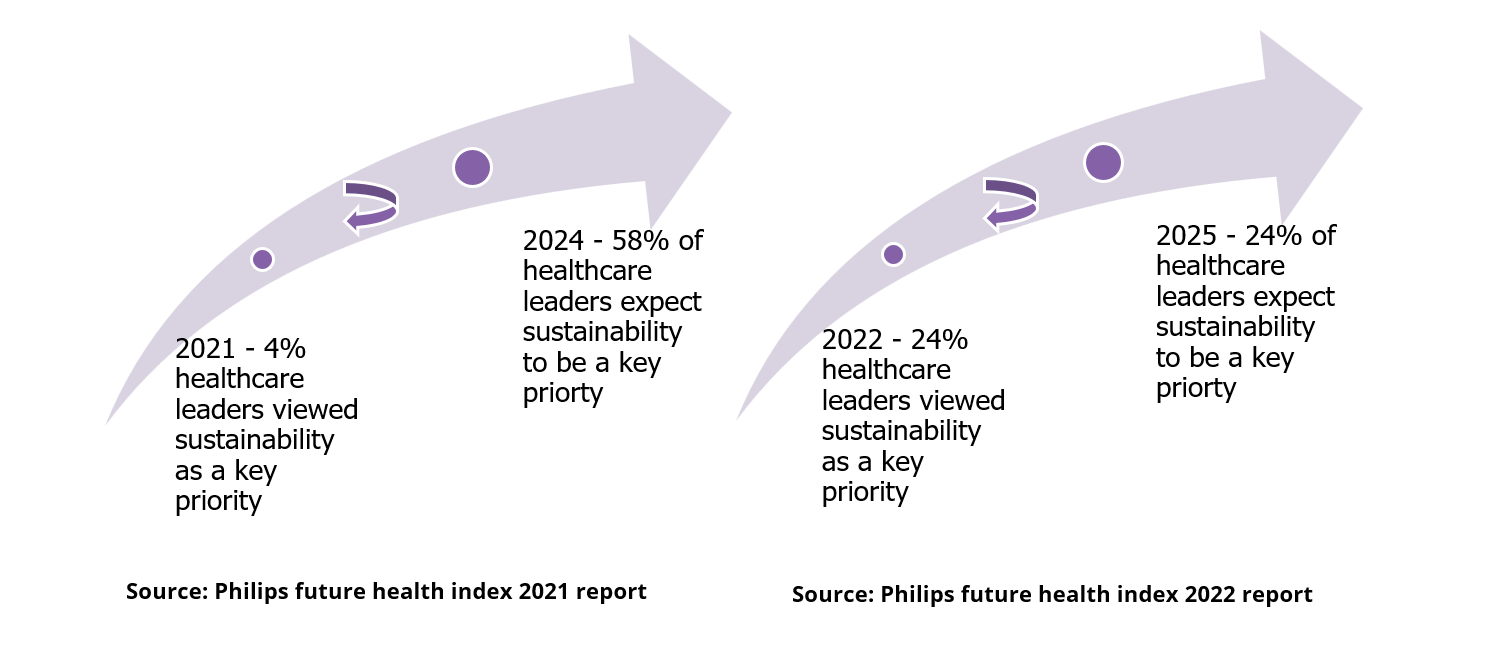
As the largest single-payer healthcare system in the world, the UK’s NHS is viewed as one of the most influential healthcare systems. However, it is also seen to be a large contributor to the UK’s carbon footprint, accounting for around 4-5% of the country’s total greenhouse emissions. In January 2020, the NHS in England announced its commitment to become the world’s first net zero health system. Anaesthetic gases are known to be a leading pollutant in the healthcare industry; in the UK, estimates from the Royal College of Anaesthetists suggest that anaesthetic gases represent five percent of the carbon footprint for all acute NHS organisations. They estimated that just under one-quarter of this carbon impact was from volatile anaesthetic gases such as desflurane, sevoflurane and isoflurane, and more than three-quarters was from nitrous oxide (N2O).
In a bid to help reduce the environmental impact of anaesthesia care, leading healthcare manufacturers in the anaesthesia industry have been developing solutions that reduce the use of anaesthetic gases during anaesthesia procedures. Many of these players have not only developed medical solutions to combat the rise in pollutants but have also employed their own sustainability programs to reduce their impact on overall CO2 levels, with many companies promising to become CO2-neutral within a set timeframe.
Low-flow anaesthesia
Low-flow anaesthesia has been a technique that has been present in the industry for some time. The technique is utilised to reduce the consumption of fresh flow gas to below that of patient’s minute ventilation. Benefits are seen when the fresh flow gas is reduced to below 3.0 L/min. Low-flow anaesthesia is when the free gas flow is reduced to below 1.0 L/min and below 0.5 L/min is classified as minimal flow anaesthesia. During low-flow and minimal-flow anaesthesia, anaesthetic gases in the patient’s exhalation air are returned to the patient via closed or semi-closed rebreathing systems. This subsequently reduces not only anaesthetic gas usage, but also reduces the release of pollutants during anaesthesia provision. Manufacturers also claim that recircled gas is often warm and humid, improving the quality of care provided whilst receiving anaesthesia.
Low-flow and minimal flow anaesthesia requires a higher level of patient monitoring of both inspiratory and expiratory gas concentrations, to ensure the patient is not affected by the change in flow and optimum gas concentrations are maintained. Subsequently leading anaesthesia vendors have developed additional clinical support technology to provide guidance on optimum anaesthesia delivery.
Closed loop anaesthesia
Closed-loop anaesthesia aims to provide automated anaesthesia delivery, by monitoring the patient to adjust anaesthesia delivery based on analysed data. Closed-loop systems have a variety of control methods allowing them to be reactive, predictive, and adaptive and improve patient safety. The optimum dosage being delivered reduces the risk of over utilisation increasing cost-efficiency and reducing wastage.
Use of TIVA
The most common technique used for maintenance of anaesthesia remains the administration of an inhaled volatile anaesthetic. However, the use of an inhalational technique is sometimes not possible, and in some situations, inhalational anaesthesia is contraindicated. In these instances, total intravenous anaesthesia (TIVA) can have advantages. As such, many anaesthesiology societies have offered guidance on clinical practice whilst offering TIVA. From a clinical point of view there is some concern about the movement to TIVA and the use of propofol and the impact on the environment. Some assessments on the lifecycle of anaesthesia have compared minimum alveolar concentration (MAC) hours of anaesthesia and TIVA. Anaesthetic gas exposures are quantified in MAC-hours, defined as an exposure at 1 time the minimum alveolar concentration that prevents movement with a noxious stimulus in 50% of subjects (MAC) for 1 hour. 1 MAC hour with 1 volatile use with volatile capture is equal to 10 with TIVA use. This will subsequently increase the use of propofol if anaesthetists move to TIVA.
Product developments within the anaesthesia market from leading players include:
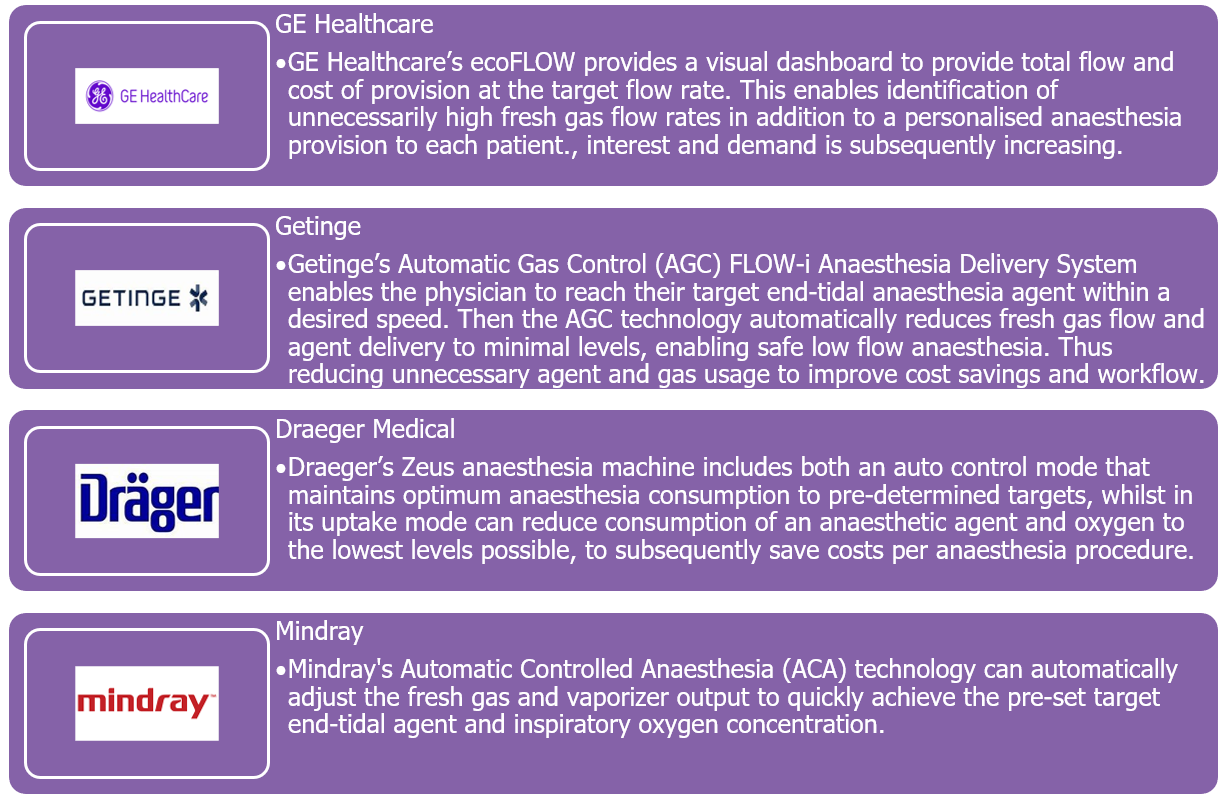
Newer Technology
With increasing concern over the environmental impact of utilising anaesthetic gases during anaesthesia, several developments have been made to capture these gases and recycle them accordingly. Gas capture purifies and enables the reuse of anaesthetic gases. It is expected to reduce the need to manufacture virgin anaesthesia gases. This will also stop the release of potent gases and the damaging manufacturing impact. As gas capture develops and becomes more efficient, there is the ability to recycle gases multiple times. The topic of gas capture is controversial between anaesthesia vendors interested in reducing the environmental impact of anaesthesia and pharmaceutical companies who will see loses through the reduction in demand for anaesthetic agents. Vendors active in gas capture include:
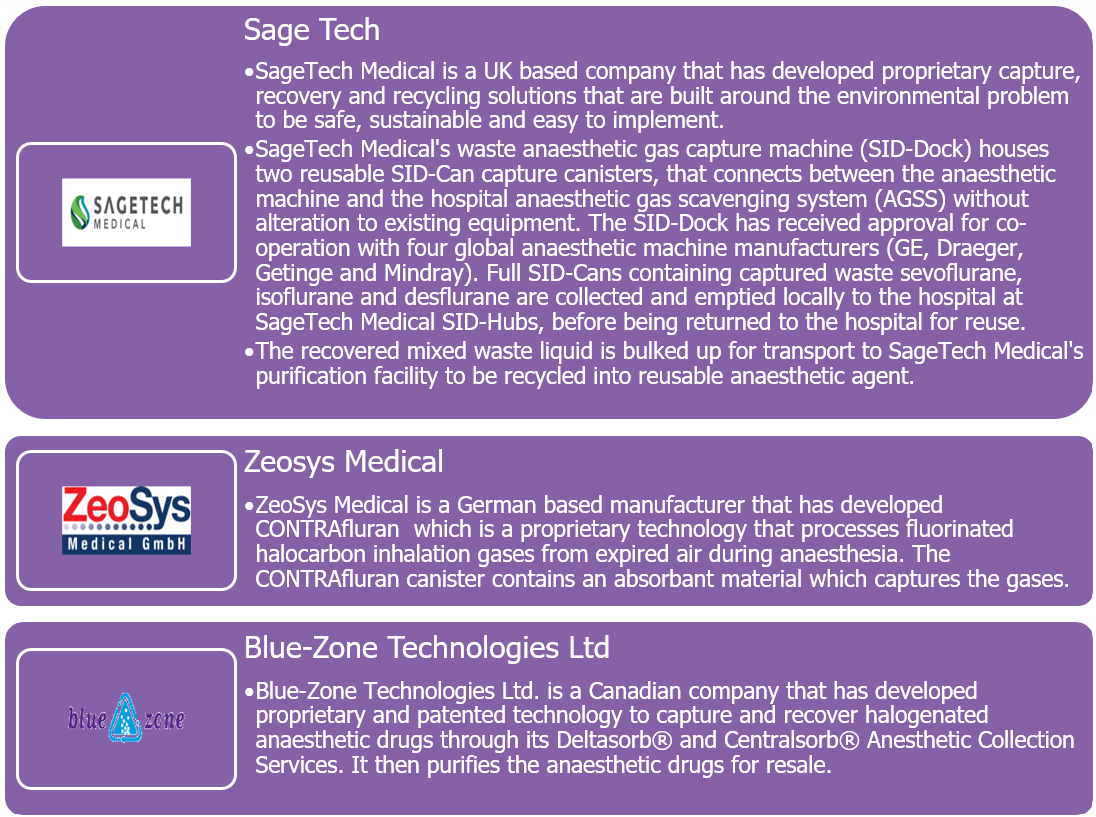
What next?
Additional developments are expected in gas capture with increased focus to reduce the environmental impact of anaesthesia. It is also expected that the leading players within the anaesthesia delivery market will continue to partner closely with the with vendors developing innovative technologies to build their wider portfolio of anaesthesia solutions and become innovative providers driving for sustainability.
About the Report
Signify Research’s upcoming report Anaesthesia Devices Report – 2023 will build on their 2021-edition and will provide a data-centric and global outlook of the market. The report will blend primary data collected from in-depth interviews with healthcare professionals and technology vendors, to provide a balanced and objective view of the market.
About Signify Research
Signify Research is an independent supplier of market intelligence and consultancy to the global healthcare technology industry. Our major coverage areas are Healthcare IT, Medical Imaging and Digital Health. Our clients include technology vendors, healthcare providers and payers, management consultants and investors. Signify Research is headquartered in Cranfield, UK. To find out more: enquiries@signifyresearch.net, T: +44 (0) 1234 436 150, www.signifyresearch.net
More Information
To find out more:
E: enquiries@signifyresearch.net
T: +44 (0) 1234 986111
www.signifyresearch.net
